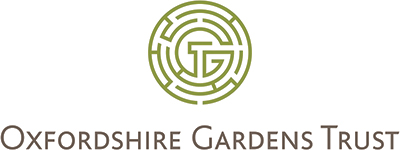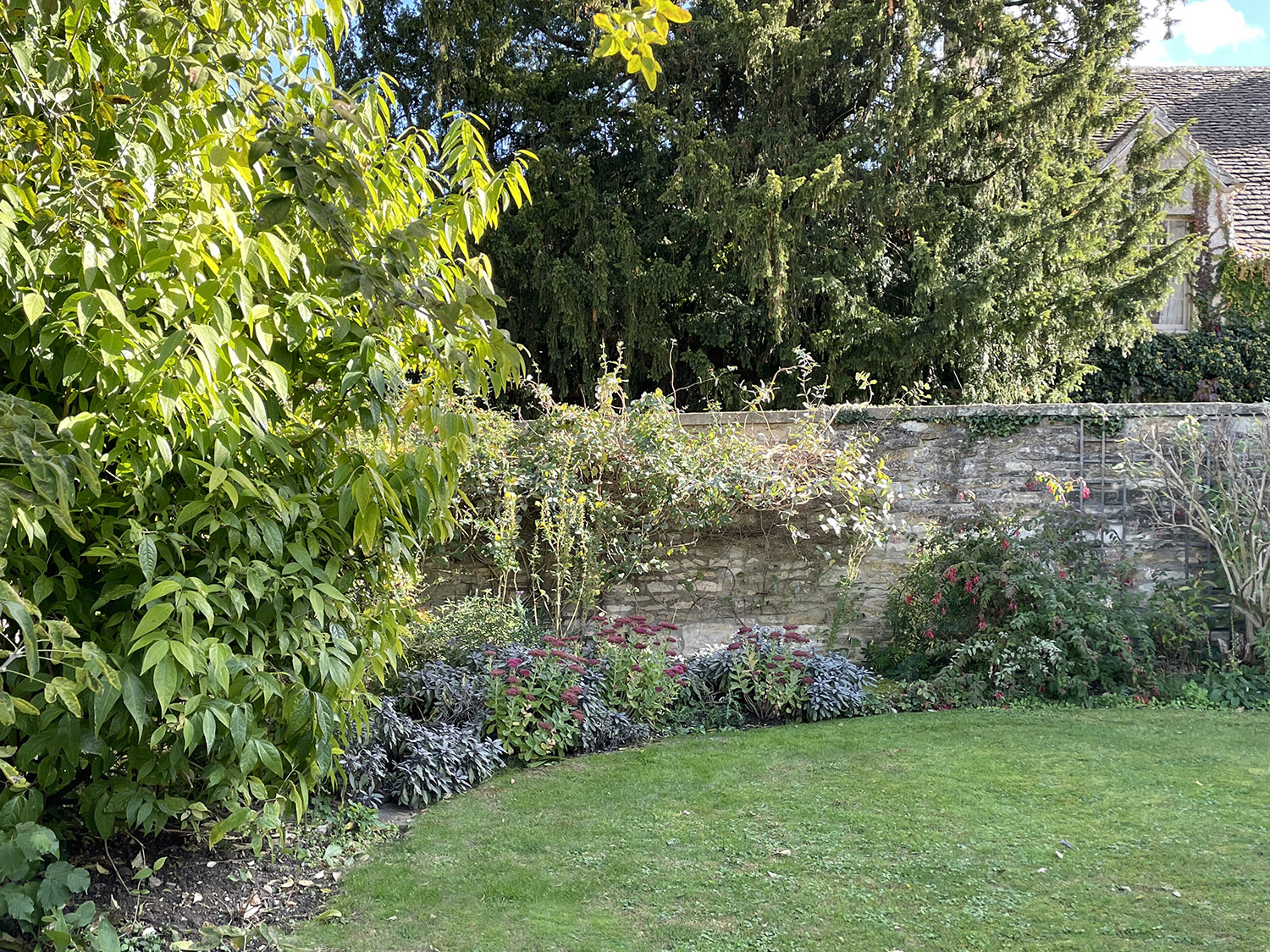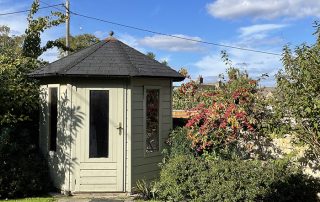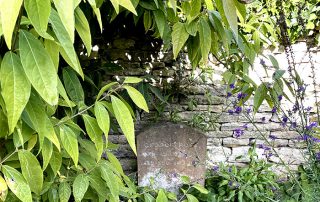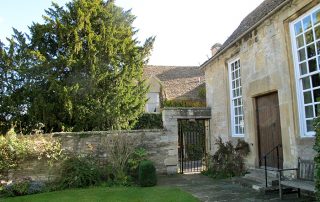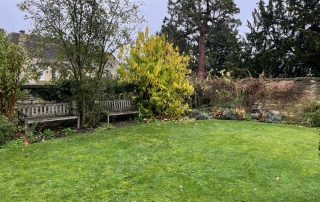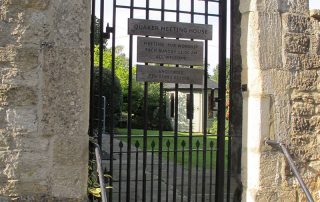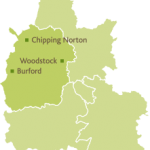Overview
A well-preserved early 18th century Quaker meeting house with a small burial ground attached, now used as a garden for reflection, social meetings and events. Both the meeting house and the east wall of the burial ground are listed Grade II*.
Historic Development
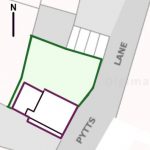
Plan of Quaker Meeting House
The meeting house was built in 1709 as a Quaker meeting space. Stairs lead to a gallery around the main meeting room and eventually to an attic room that was formed c. 1730, intended as a meeting room for women. The wooden fittings for the gallery, panelling, stairs and handrails are notably plain and are thought to be original. Some minor adjustments have been made to the internal detail of the building. Architectural details of the original meeting house are available elsewhere (Oxfordshire Buildings Record, 2010; Heritage Quakers, 2016; English Heritage, 2019).
An extension was added to the west side of the house in 1981 as a single-storey structure in similar materials. This connects directly with the main house. Disabled access via a ramp was also added to the west side of the extension.
Context and Setting
Pytts Lane lies to the east of the Burford High Street, approximately parallel and orientated north–south. The area of the buildings and garden is c. 310m2, with the rectangular garden occupying c. 200m2. The garden comprises principally lawn with borders on the north, east and west sides, and the original house and modern extension occupying the south side. From the buildings on the south side, the garden faces north and is frequently in the shade. The garden slopes very gradually downwards (to the north) away from the house.
The garden wall on the east side, adjacent to the street, is the 18th century coursed rubble stone wall with stone coping, listed alongside the house as Grade II*. This wall has a slight angle mid-way along, where the street narrows and marginally changes direction. The garden walls to the north and west are coursed drystone.
Entrances and Approaches
The main entrance to the house and garden is on the east side (NE of the house, SE of the garden) from Pytts Lane. This comprises five stone steps up to an entrance through the east wall, with large stone quoins and a shaped stone lintel. The iron gate bears the date 1709 near the top. Recent notice boards are attached to the gate, above the gate and to the adjacent wall.
Disabled access is available at the south-west corner of the property from a lane running west off Pytts Lane. This ramp runs past the west side of the modern extension to a door leading to the extension and to the garden.
The Garden
The garden was completely re-designed in 2009 to celebrate the tercentenary of Quaker association with the building. The burial ground had become a little out of control and was transformed into a more traditional garden by two Quakers from Burford – Maida Sturge, in collaboration with the alpine specialist, Irene Glaister (1922 – 2013). The only remnant of the original burial ground is a surviving headstone to George Rose (1835 – 1905) and his wife Catherine, which is set against the north wall to the east of two wooden benches.
The redesign removed a large holly tree that was blocking light into the meeting house and also thinned a tall laburnum tree in the centre of the north border. New planting in the borders to the north and west included fragrant spring flowering trees, designed to blossom in succession with underplanting of spring bulbs and shrubs. Added to the west border were an almond (unfortunately dead from disease), a magnolia and a prunus. To the north border were planted a Chimonanthus praecox (Wintersweet), a Deutzia gracilis and a Malus baccata (Crab apple var Siberian/Manchurian).
Some hard landscaping was enhanced to extend the stone flagged area in front of the meeting house, to adjust stone walls to retain the planting borders, and to re-arrange flagstone bases for benches and the summerhouse.
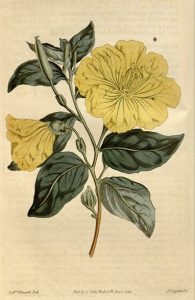
Oenothera (biennis) Missouri, supposedly brought from North America by the Quaker John Fothergill, by permission of Missouri Botanical Garden, Peter H. Raven Library
The intention with the east border, known as the Quaker Garden, was to fill it with plants that have Quaker associations. In the centre a mill wheel shaped paving area was constructed, which enabled people to stand among the flowers and read an oak plaque on the east wall, listing Quaker plant-hunters, naturalists and nurserymen who played a part in establishing different species in UK gardens. Amongst those listed were William Curtis (1746 – 1799), a plant-hunter, who attended school in Burford and who introduced the Chelone Obliqua (Twisted shell flower) to Britain, which was planted against the east wall. Also John Fothergill (1712 – 1780) from whom we have Oenothera biennia (Evening primrose), now prolific in the garden. Originally planted with alpines, herbaceous plants, perennials and small shrubs, advised by Irene Glaister, the plants were not suitable for the soil and apart from the Evening primrose and a honeysuckle, all have died. They have been replaced with American red currant, buddleia, jasmine, fuchsia, tree peony, rose, sage, salvia, hellebore, sedum and rosa rugosa alba.
Later plantings in the north border has a tree peony and a hebe and in the west border euphorbia, cotoneaster skimmia and hebe. Honeysuckle twists around the rail of the disabled ramp at the bottom of which to the south is a large yew, and to the north a tall viburnum. Against the house near the entrance there is a cotoneaster. The garden has low box hedges on either side of the summerhouse and to the north of the main entrance.
The garden has five wooden benches, two against the north wall near the centre, two at right angles to each other at the west corner of the garden (below the ramp) and the third against the house at the west side of the door. A hexagonal summerhouse sits in the north-west corner of the garden.
Address
Pytts Lane, Burford, Oxfordshire OX18 4SJ
Name of district
Parish of Burford, West Oxfordshire
Grid reference
SP 2524 1210
Sources of information
English Heritage (2019): Burford Quaker Meeting House With Attached Burial Ground Wall. List Entry Number: 1266442 [Online]. Available at: https:// www.heritagegateway.org.uk/Gateway/Results_Single.aspx?uid=1266442&resourceID=5
(Accessed 28 November 2022)
Heritage Quakers (2016) Friends Meeting House, Burford [Online]. Available at:
https://heritage.quaker.org.uk/files/Burford%20LM.pdf (Accessed 28 November 2022)
Oxfordshire Buildings Record (2010) Oxfordshire Buildings Record Report OBR.85 Friends [Online]. Available at: www.obr.org.uk/wp-content/uploads/2020/05/85-Friends-Meeting-House-final.pdf (Accessed 28 November 2022)
Quakers in the World (n.d.) Botanists [Online]. Available at: https:// www.quakersintheworld.org/quakers-in-action/221/Botanists (Accessed 14 December 2022)
Acknowledgements
Our thanks go to members of Burford Meeting for their help and assistance.
